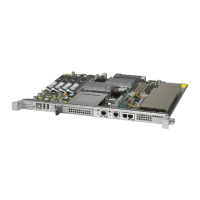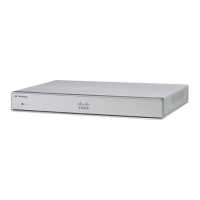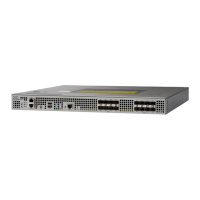11-18
Cisco 10000 Series Router Quality of Service Configuration Guide
OL-7433-09
Chapter 11 Managing Packet Queue Congestion
Controlling Congestion Using Weighted Random Early Detection
On the PRE3 and PRE4, the random-detect command is used to configure a default drop profile for a
queue and has the following syntax:
random-detect {precedence-based | dscp-based} aggregate [minimum-thresh min-thresh-value
maximum-thresh max-thresh-value mark-prob mark-prob-value]
If you enter the random-detect command without the aggregate profile (the equivalent of the PRE2
command), the PRE3 and PRE4 accept the command, but the default action is to tail drop.
random-detect {precedence-based | dscp-based}
The PRE3 and PRE4 support drop profiles based on discard class, ATM CLP and CoS bit, but do not use
the aggregate form of the command. Instead, the PRE3 and PRE4 support the PRE2 form of the
commands:
random-detect discard-class-based
random-detect discard-class discard-class-value min-thresh-value max-thresh-value
mark-probability-denominator-value
random-detect atm-clp-based
random-detect clp clp-value min-thresh-value max-thresh-value
mark-probability-denominator-value
random-detect cos cos-value min-thresh-value max-thresh-value mark-probability-denominator
Usage Guidelines for the random-detect Command
General
If you do not specify any arguments, WRED uses the default IP precedence value to calculate the drop
probability.
When specifying class policy within a policy map, you can use the random-detect command with the
bandwidth command.
To modify the queue length, always use the queue-limit command instead of the max-threshold
parameter of the random-detect command. Modifying the max-threshold parameter does not
necessarily change the queue limit. When you increase the max-threshold parameter, WRED adjusts the
queue length to be no less than the max-threshold value. However, when you reduce the max-threshold
parameter, WRED does not change the queue length.
exponential-weight-constant
The router calculates the average queue size based on the previous average and the current size of the
queue, using the following formula:
Average = (old-average * (1 – 2 – n)) + (current-queue-size * 2 – n)
where n is the exponential weight constant
For MPLS packets, when you use precedence-based WRED, the router calculates the average queue size
using the MPLS experimental (EXP) bits.
random-detect dscp
You must first enable the drop mode by using the random-detect dscp-based command. You can then
set the drop probability profile by using the random-detect dscp command.
With the dscp-based keyword, WRED uses the DSCP value (that is, the first six bits of the IP type of
service (ToS) byte) to calculate the drop probability.

